CHRYSLER 300 2005 1.G Owners Manual
Manufacturer: CHRYSLER, Model Year: 2005, Model line: 300, Model: CHRYSLER 300 2005 1.GPages: 374, PDF Size: 6.8 MB
Page 311 of 374
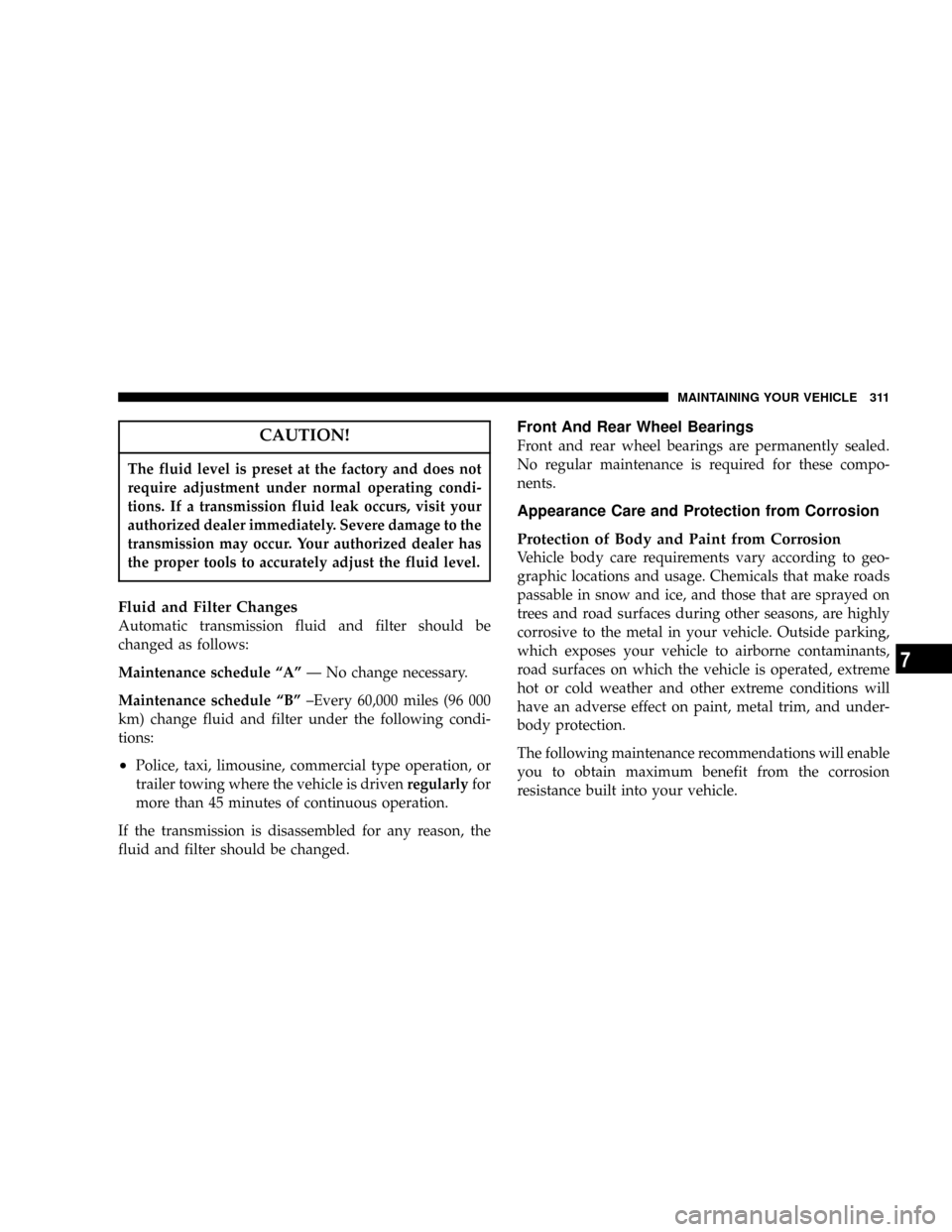
CAUTION!
The fluid level is preset at the factory and does not
require adjustment under normal operating condi-
tions. If a transmission fluid leak occurs, visit your
authorized dealer immediately. Severe damage to the
transmission may occur. Your authorized dealer has
the proper tools to accurately adjust the fluid level.
Fluid and Filter Changes
Automatic transmission fluid and filter should be
changed as follows:
Maintenance schedule ªAºÐ No change necessary.
Maintenance schedule ªBº±Every 60,000 miles (96 000
km) change fluid and filter under the following condi-
tions:
²Police, taxi, limousine, commercial type operation, or
trailer towing where the vehicle is drivenregularlyfor
more than 45 minutes of continuous operation.
If the transmission is disassembled for any reason, the
fluid and filter should be changed.
Front And Rear Wheel Bearings
Front and rear wheel bearings are permanently sealed.
No regular maintenance is required for these compo-
nents.
Appearance Care and Protection from Corrosion
Protection of Body and Paint from Corrosion
Vehicle body care requirements vary according to geo-
graphic locations and usage. Chemicals that make roads
passable in snow and ice, and those that are sprayed on
trees and road surfaces during other seasons, are highly
corrosive to the metal in your vehicle. Outside parking,
which exposes your vehicle to airborne contaminants,
road surfaces on which the vehicle is operated, extreme
hot or cold weather and other extreme conditions will
have an adverse effect on paint, metal trim, and under-
body protection.
The following maintenance recommendations will enable
you to obtain maximum benefit from the corrosion
resistance built into your vehicle.
MAINTAINING YOUR VEHICLE 311
7
Page 312 of 374

What Causes Corrosion?
Corrosion is the result of deterioration or removal of
paint and protective coatings from your vehicle.
The most common causes are:
²Road salt, dirt and moisture accumulation.
²Stone and gravel impact.
²Insects, tree sap and tar.
²Salt in the air near seacoast localities.
²Atmospheric fallout/industrial pollutants.
Washing
²
Wash your vehicle regularly. Always wash your ve-
hicle in the shade using a mild car wash soap, and
rinse the panels completely with clear water.
²If insects, tar or other similar deposits have accumu-
lated on your vehicle, wash it as soon as possible.
²Use Mopar auto polish to remove road film and stains
and to polish your vehicle. Take care never to scratch
the paint.
²Avoid using abrasive compounds and power buffing
that may diminish the gloss or thin out the paint
finish.
CAUTION!
Do not use abrasive or strong cleaning materials
such as steel wool or scouring powder, which will
scratch metal and painted surfaces.
Special Care
²
If you drive on salted or dusty roads or if you drive
near the ocean, hose off the undercarriage at least once
a month.
²It is important that the drain holes in the lower edges
of the doors, rocker panels and trunk be kept clear and
open.
²If you detect any stone chips or scratches in the paint,
touch them up immediately. The cost of such repairs is
considered the responsibility of the owner.
312 MAINTAINING YOUR VEHICLE
Page 313 of 374

²If your vehicle is damaged due to an accident or
similar cause which destroys the paint and protective
coating have your vehicle repaired as soon as possible.
The cost of such repairs is considered the responsibil-
ity of the owner.
²All wheels and wheel trim, especially aluminum and
chrome plated wheels should be cleaned regularly
with mild soap and water to prevent corrosion. To
remove heavy soil, select a nonabrasive, non-acidic
cleaner. Do not use scouring pads, steel wool, a bristle
brush or metal polishes. Only Mopar cleaners are
recommended. Do not use oven cleaner. Avoid auto-
matic car washes that use acidic solutions or harsh
brushes that may damage the wheels' protective fin-
ish.
²If you carry special cargo such as chemicals, fertilizers,
de-icer salt, etc., be sure that such materials are well
packaged and sealed.
²If a lot of driving is done on gravel roads, consider
mud or stone shields behind each wheel.
²Use Mopar touch up paint on scratches as soon as
possible. Your dealer has touch up paint to match the
color of your vehicle.
Interior Care
Use Mopar Fabric Cleaner to clean fabric upholstery and
carpeting.
Interior Trim should be cleaned starting with a damp
cloth, a damp cloth with a mild detergent, then MOPAR
Vinyl Cleaner if absolutely necessary. Do not use harsh
cleaners or Armorall. Use Mopar Vinyl Cleaner to clean
vinyl upholstery.
Mopar Total Clean is specifically recommended for
leather upholstery.
Your leather upholstery can be best preserved by regular
cleaning with a damp soft cloth. Small particles of dirt
can act as an abrasive and damage the leather upholstery
and should be removed promptly with a damp cloth.
Stubborn soils can be removed easily with a soft cloth
and Mopar Total Clean. Care should be taken to avoid
soaking your leather upholstery with any liquid. Please
MAINTAINING YOUR VEHICLE 313
7
Page 314 of 374

do not use polishes, oils, cleaning fluids, solvents, deter-
gents, or ammonia based cleaners to clean your leather
upholstery. Application of a leather conditioner is not
required to maintain the original condition.
WARNING!
Do not use volatile solvents for cleaning purposes.
Many are potentially flammable, and if used in
closed areas they may cause respiratory harm.
Glass Surfaces
All glass surfaces should be cleaned on a regular basis
with any commercial household-type glass cleaner.
Never use an abrasive type cleaner. Use caution when
cleaning the inside rear window equipped with electric
defrosters or the right rear quarter window equipped
with the radio antenna. Do not use scrapers or other
sharp instruments which may scratch the elements.
When cleaning the rear view mirror, spray cleaner on the
towel or rag that you are using. Do not spray cleaner
directly on the mirror.
Cleaning Plastic Instrument Cluster Lenses
The lenses in front of the instruments in this vehicle are
molded in clear plastic. When cleaning the lenses, care
must be taken to avoid scratching the plastic.
1. Clean with a wet soft rag. A mild soap solution may be
used, but do not use high alcohol content or abrasive
cleaners. If soap is used, wipe clean with a clean damp
rag.
2. Dry with a soft tissue.
Seat Belt Maintenance
Do not bleach, dye or clean the belts with chemical
solvents or abrasive cleaners. This will weaken the fabric.
Sun damage can also weaken the fabric.
If the belts need cleaning, use a mild soap solution or
lukewarm water. Do not remove the belts from the car to
wash them.
Replace the belts if they appear frayed or worn or if the
buckles do not work properly.
314 MAINTAINING YOUR VEHICLE
Page 315 of 374

Cleaning The Center Console Cup Holders Ð 300
Perform the following steps to clean the center console
cup holders:
²Grab the center of the rubber portion of the cup holder
firmly and lift upward to remove.
²Soak the rubber cup holder liner in a mixture of
medium hot tap water and one teaspoon of mild liquid
dish soap. Let soak for approximately one hour.
²After one hour pull the liner from the water and dip it
back into the water about six times. This will loosen
any remaining debris.
²Rinse the liner thoroughly under warm running water.
Shake the excess water from the liner and dry the
outer surfaces with a clean soft cloth.
²Carefully tuck the front, followed by the rear, then side
edges of the cup holder into the center console.
Cleaning The Center Console Cup Holders Ð
300C, 300 Touring
Clean with a damp cloth or towel using a mild detergent
with the cup holder in the center console.
NOTE:The 300 Touring, and 300C cup holder cannot be
removed.
Power Distribution Centers
Front Power Distribution Center
A power distribution center is located in the engine
compartment. This center contains fuses and relays.
MAINTAINING YOUR VEHICLE 315
7
Page 316 of 374
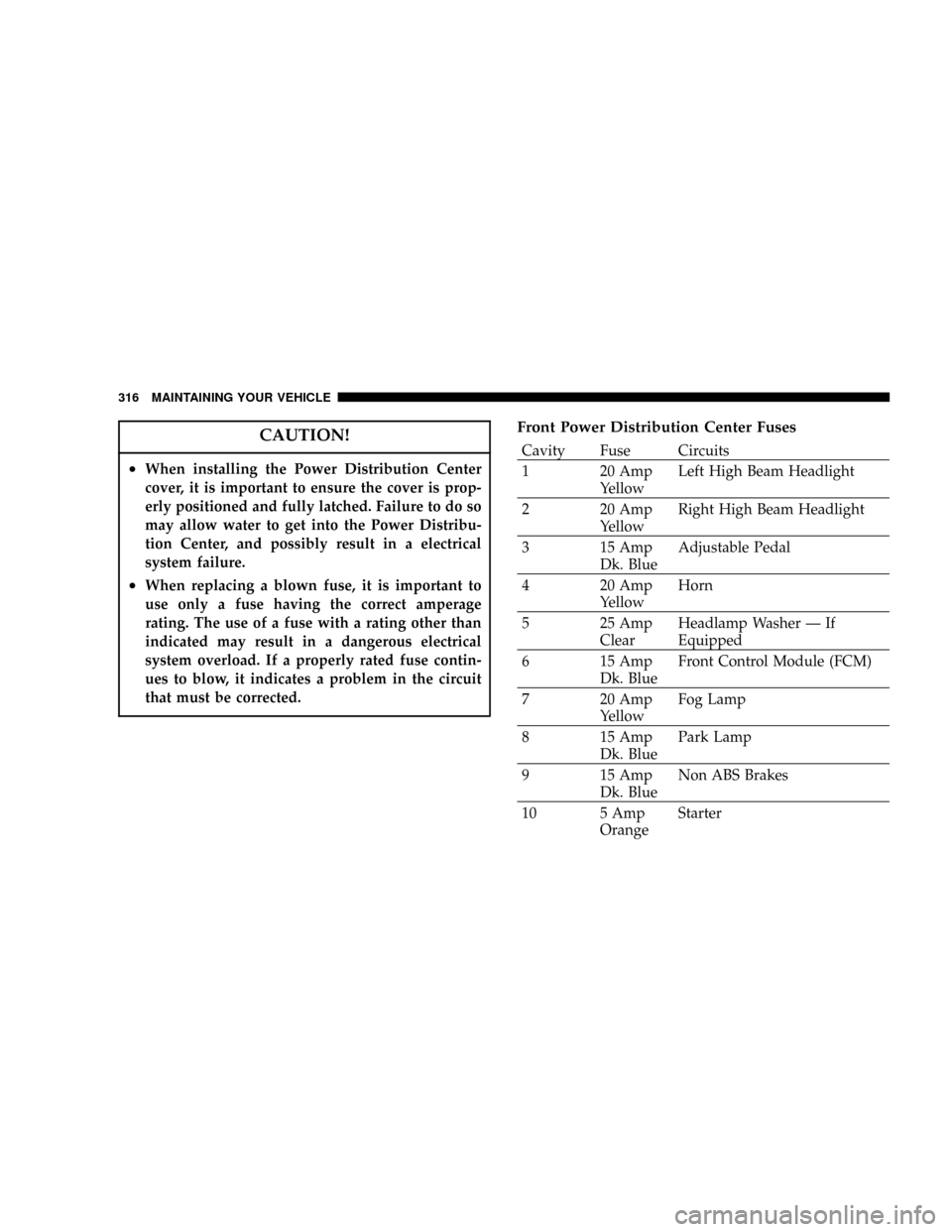
CAUTION!
²When installing the Power Distribution Center
cover, it is important to ensure the cover is prop-
erly positioned and fully latched. Failure to do so
may allow water to get into the Power Distribu-
tion Center, and possibly result in a electrical
system failure.
²When replacing a blown fuse, it is important to
use only a fuse having the correct amperage
rating. The use of a fuse with a rating other than
indicated may result in a dangerous electrical
system overload. If a properly rated fuse contin-
ues to blow, it indicates a problem in the circuit
that must be corrected.
Front Power Distribution Center Fuses
Cavity Fuse Circuits
1 20 Amp
YellowLeft High Beam Headlight
2 20 Amp
YellowRight High Beam Headlight
3 15 Amp
Dk. BlueAdjustable Pedal
4 20 Amp
YellowHorn
5 25 Amp
ClearHeadlamp Washer Ð If
Equipped
6 15 Amp
Dk. BlueFront Control Module (FCM)
7 20 Amp
YellowFog Lamp
8 15 Amp
Dk. BluePark Lamp
9 15 Amp
Dk. BlueNon ABS Brakes
10 5 Amp
OrangeStarter
316 MAINTAINING YOUR VEHICLE
Page 317 of 374
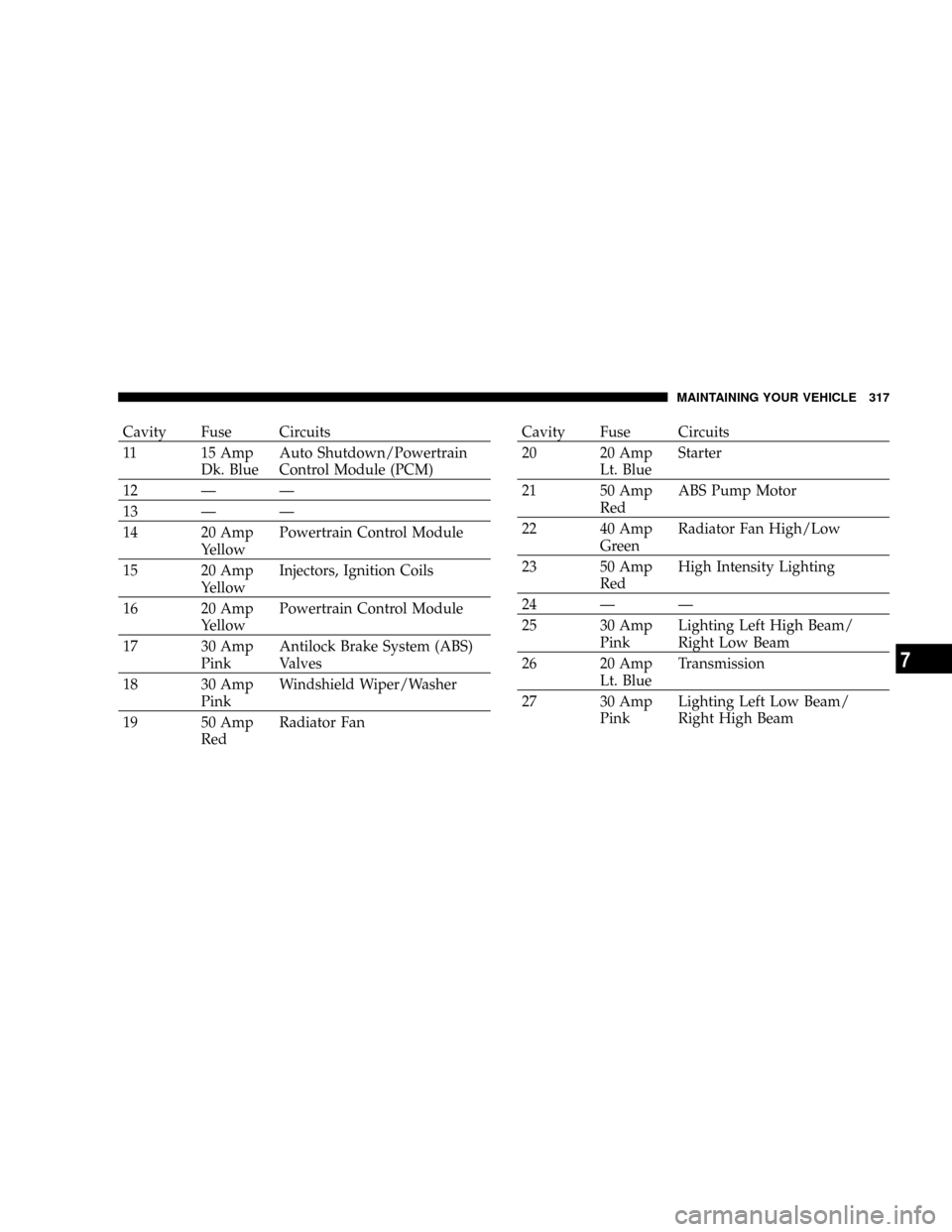
Cavity Fuse Circuits
11 15 Amp
Dk. BlueAuto Shutdown/Powertrain
Control Module (PCM)
12ÐÐ
13ÐÐ
14 20 Amp
YellowPowertrain Control Module
15 20 Amp
YellowInjectors, Ignition Coils
16 20 Amp
YellowPowertrain Control Module
17 30 Amp
PinkAntilock Brake System (ABS)
Valves
18 30 Amp
PinkWindshield Wiper/Washer
19 50 Amp
RedRadiator FanCavity Fuse Circuits
20 20 Amp
Lt. BlueStarter
21 50 Amp
RedABS Pump Motor
22 40 Amp
GreenRadiator Fan High/Low
23 50 Amp
RedHigh Intensity Lighting
24ÐÐ
25 30 Amp
PinkLighting Left High Beam/
Right Low Beam
26 20 Amp
Lt. BlueTransmission
27 30 Amp
PinkLighting Left Low Beam/
Right High Beam
MAINTAINING YOUR VEHICLE 317
7
Page 318 of 374

Rear Power Distribution Center
There is also a power distribution center located in the
trunk under the spare tire access panel. This center
contains fuses and relays.
318 MAINTAINING YOUR VEHICLE
Page 319 of 374
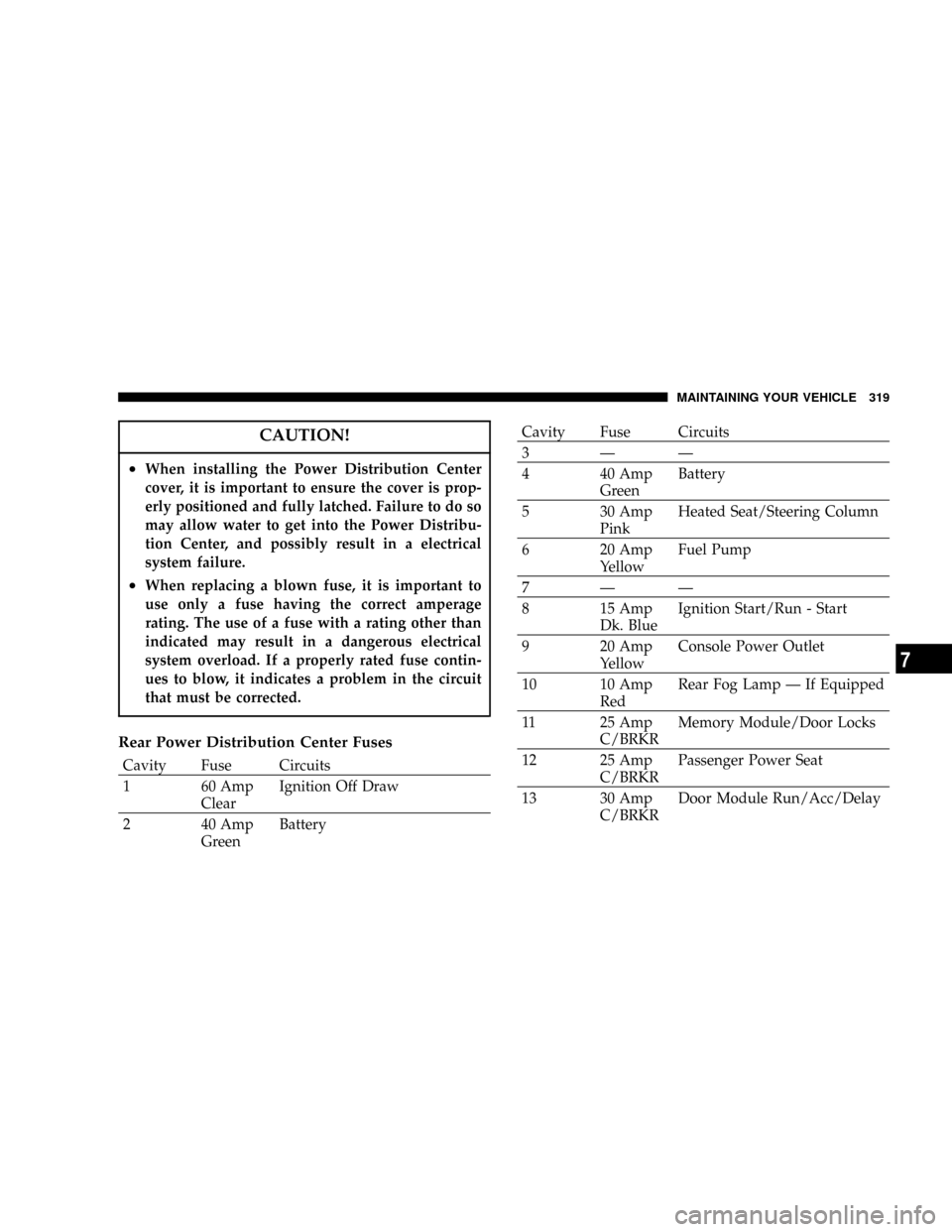
CAUTION!
²When installing the Power Distribution Center
cover, it is important to ensure the cover is prop-
erly positioned and fully latched. Failure to do so
may allow water to get into the Power Distribu-
tion Center, and possibly result in a electrical
system failure.
²When replacing a blown fuse, it is important to
use only a fuse having the correct amperage
rating. The use of a fuse with a rating other than
indicated may result in a dangerous electrical
system overload. If a properly rated fuse contin-
ues to blow, it indicates a problem in the circuit
that must be corrected.
Rear Power Distribution Center Fuses
Cavity Fuse Circuits
1 60 Amp
ClearIgnition Off Draw
2 40 Amp
GreenBattery
Cavity Fuse Circuits
3ÐÐ
4 40 Amp
GreenBattery
5 30 Amp
PinkHeated Seat/Steering Column
6 20 Amp
YellowFuel Pump
7ÐÐ
8 15 Amp
Dk. BlueIgnition Start/Run - Start
9 20 Amp
YellowConsole Power Outlet
10 10 Amp
RedRear Fog Lamp Ð If Equipped
11 25 Amp
C/BRKRMemory Module/Door Locks
12 25 Amp
C/BRKRPassenger Power Seat
13 30 Amp
C/BRKRDoor Module Run/Acc/Delay
MAINTAINING YOUR VEHICLE 319
7
Page 320 of 374
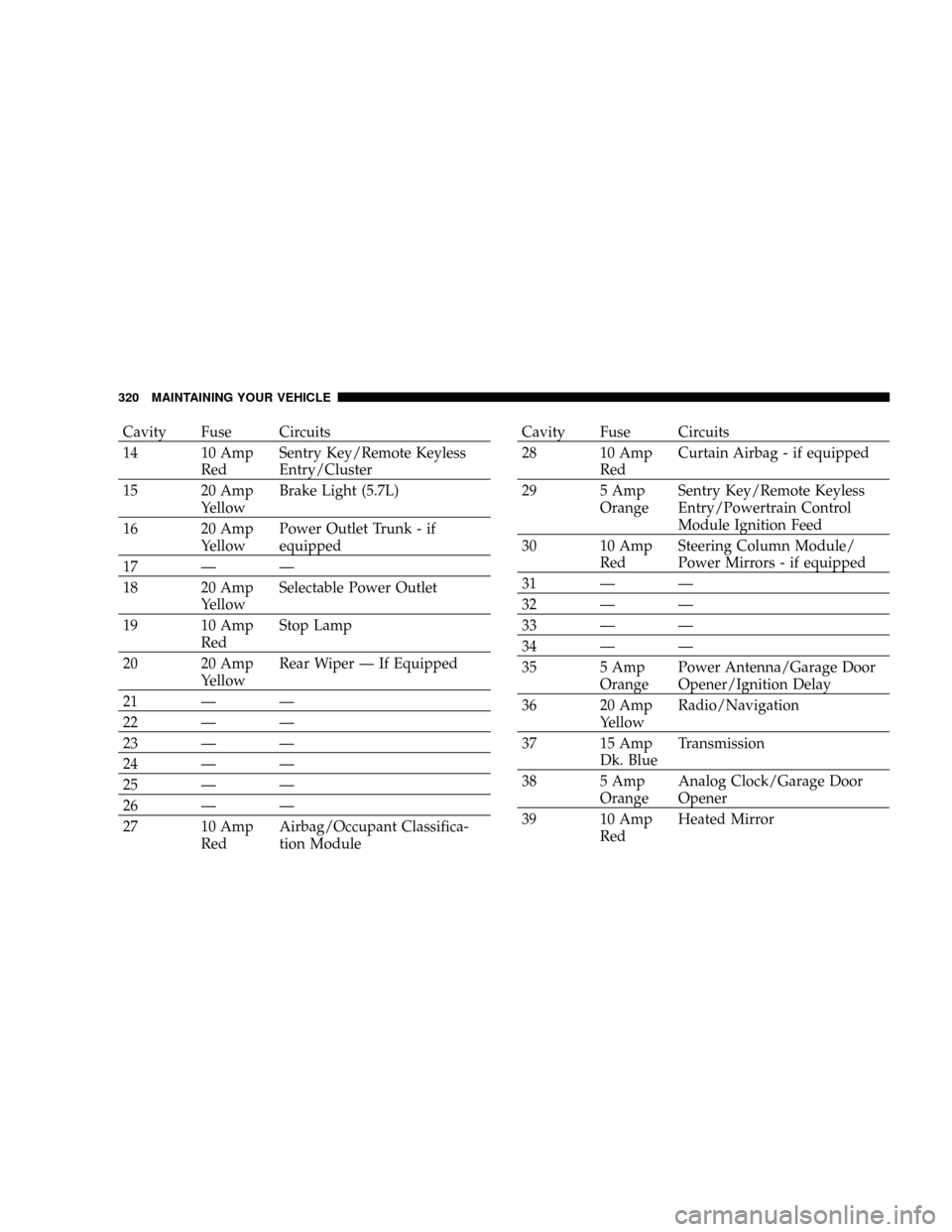
Cavity Fuse Circuits
14 10 Amp
RedSentry Key/Remote Keyless
Entry/Cluster
15 20 Amp
YellowBrake Light (5.7L)
16 20 Amp
YellowPower Outlet Trunk - if
equipped
17ÐÐ
18 20 Amp
YellowSelectable Power Outlet
19 10 Amp
RedStop Lamp
20 20 Amp
YellowRear Wiper Ð If Equipped
21ÐÐ
22ÐÐ
23ÐÐ
24ÐÐ
25ÐÐ
26ÐÐ
27 10 Amp
RedAirbag/Occupant Classifica-
tion ModuleCavity Fuse Circuits
28 10 Amp
RedCurtain Airbag - if equipped
29 5 Amp
OrangeSentry Key/Remote Keyless
Entry/Powertrain Control
Module Ignition Feed
30 10 Amp
RedSteering Column Module/
Power Mirrors - if equipped
31ÐÐ
32ÐÐ
33ÐÐ
34ÐÐ
35 5 Amp
OrangePower Antenna/Garage Door
Opener/Ignition Delay
36 20 Amp
YellowRadio/Navigation
37 15 Amp
Dk. BlueTransmission
38 5 Amp
OrangeAnalog Clock/Garage Door
Opener
39 10 Amp
RedHeated Mirror
320 MAINTAINING YOUR VEHICLE